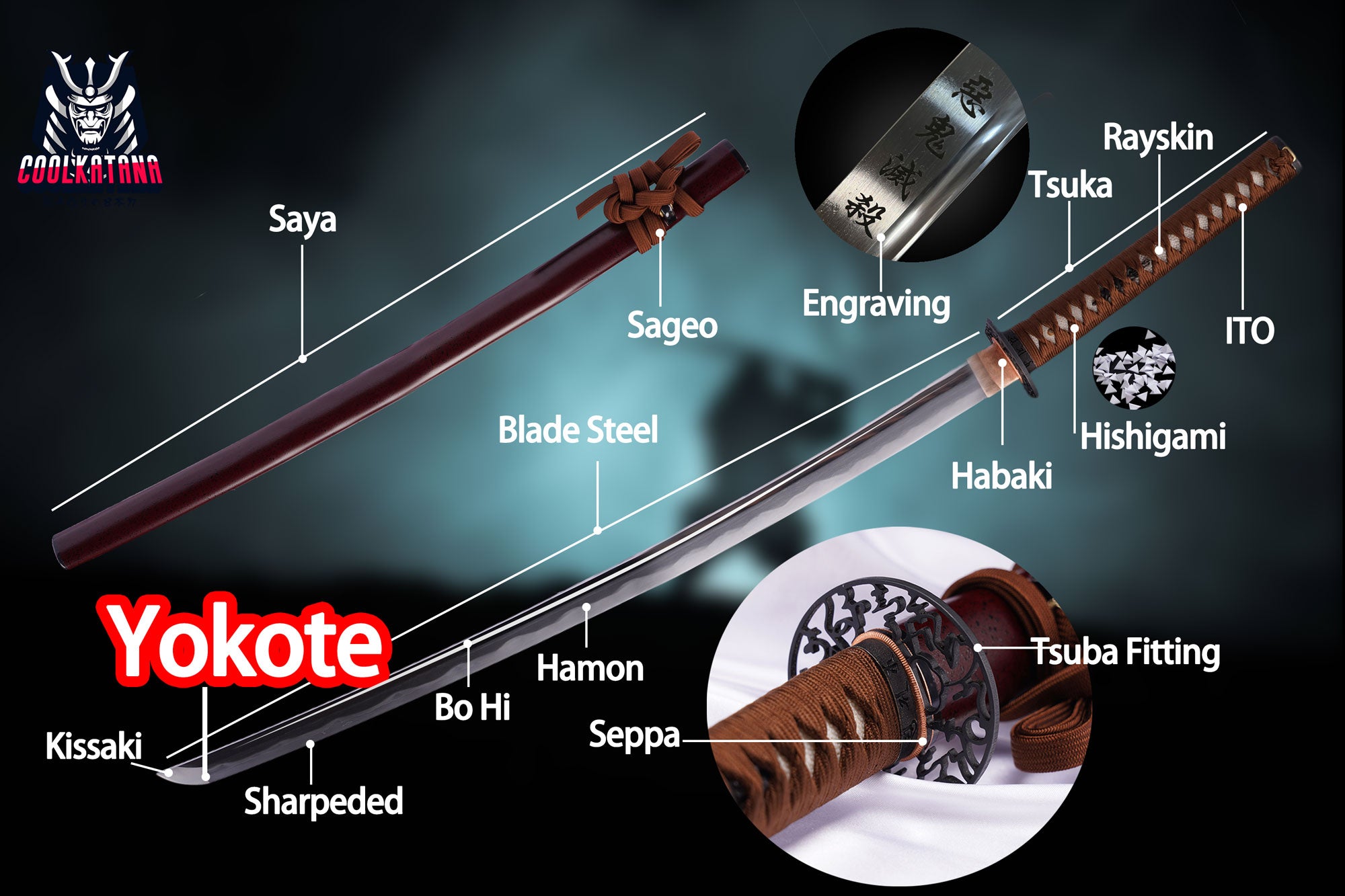Types and Features of Yokote in Samurai Swords: Design and Benefits
- Posted by COOLKATANA

Types and Features of the Yokote in Samurai Swords
Yokote (横手) is an essential feature of the Japanese katana, referring to the horizontal line or fold near the tip of the blade. This element plays a significant role not only in the aesthetics but also in the performance of the sword, offering both visual and functional benefits. The Yokote helps distinguish the cutting edge from the tip, provides durability, and enhances the cutting efficiency of the blade.
Characteristics and Function of the Yokote:
-
Design and Function: The Yokote typically appears about one-third of the way from the tip of the blade. It is handcrafted by swordsmiths and serves to mark the boundary between the cutting edge and the tip. The presence of Yokote reduces resistance during cuts, enhancing the sword’s cutting efficiency.
-
Aesthetic Value: Beyond its functional role, the Yokote also holds significant aesthetic value. It is a symbol of the swordsmith's craftsmanship, adding beauty and depth to the blade, and is often considered a mark of high artistry in traditional katana-making.
-
Tip Protection: The Yokote serves as a protective feature for the sword's tip, which is the most vulnerable part of the blade. Its design ensures the tip remains strong and durable even after prolonged use.
Types of Yokote and Their Advantages:
1. Ornamental Yokote
The Ornamental Yokote is primarily designed for visual appeal and aesthetic value. It is usually shallower and features softer lines, focusing more on the appearance of the blade rather than its cutting performance. This design is commonly found in high-end collectible swords and ceremonial pieces, often accompanied by intricate patterns and gilded embellishments.
Advantages of Ornamental Yokote:
- High Aesthetic Value: It enhances the sword's artistic appeal, commonly seen in collectible and commemorative blades.
- Craftsmanship Display: The design reflects the swordsmith's skill, requiring intricate craftsmanship.
- Visual Depth: The distinct line of the Yokote adds layers to the blade’s design, making it look more dynamic and refined.
Ideal for: Collectible, ceremonial, or artistic swords, emphasizing aesthetics over practical use.

2. Geometric Yokote
The Geometric Yokote features precise and clear geometric lines that are carefully aligned with the sword’s shape. These lines enhance the structural integrity and visual clarity of the blade. The geometric design creates more stability in the cutting edge, with sharp, symmetrical lines that also impart a modern look to the sword.
Advantages of Geometric Yokote:
- Improved Blade Stability: The structured design increases blade stability, reducing friction during cuts and maintaining sharpness.
- Enhanced Tip Strength: The geometric shape strengthens the tip, making it more resilient to breakage or damage.
- Modern Aesthetic: Offers a more contemporary and symmetrical look, blending functionality with visual harmony.
Ideal for: Users who prioritize both blade performance and a modern aesthetic, such as for daily use or practical applications.

3. No Yokote
The No Yokote design eliminates the horizontal line entirely, offering a smooth and seamless transition from the blade to the tip. This design is characterized by a simpler and cleaner appearance, ideal for those who appreciate minimalist styles. The blade remains fluid and streamlined, providing natural flow from the base to the tip.
Advantages of No Yokote:
- Clean, Smooth Appearance: The blade has a sleek, minimalist design without interruptions, making it look elegant and streamlined.
- Higher Cutting Efficiency: The absence of a Yokote allows for smoother cuts, reducing friction and resistance.
- Traditional and Practical: This design is often found in traditional katana, focusing on practical performance and durability, making it suitable for combat or everyday use.
Ideal for: Practical users who appreciate simplicity and prioritize performance, particularly those seeking a blade for functional, everyday use.

www.coolkatana.com
Conclusion
Each type of Yokote brings unique advantages to the katana. From the Ornamental Yokote, which enhances aesthetic value, to the Geometric Yokote, which balances performance and design, and the No Yokote, which focuses on sleek functionality, every variation is suited to different needs and preferences. The choice of Yokote design reflects the balance between artistic craftsmanship and practical use, contributing to the rich cultural legacy and evolution of the katana.

